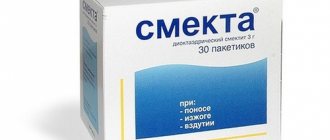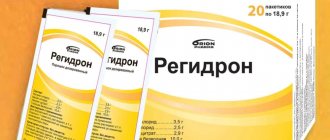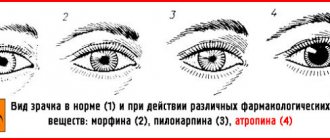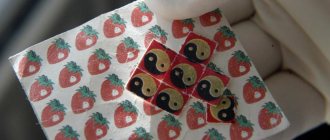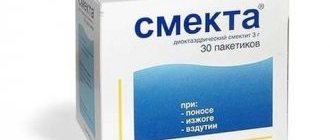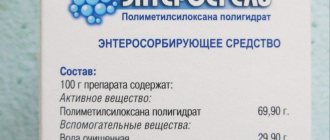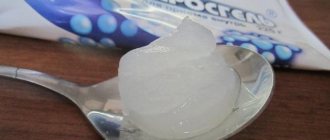Any disease brings suffering to a person. When the main symptom is vomiting, it is impossible to work or rest. Such a sign can signal serious processes in the body. But there is a way out - take Smecta when vomiting. This drug acts quickly and gives good results; it can be used by both children and adults for various problems with the gastrointestinal tract.
The benefits of Smecta for food poisoning, as well as nausea and vomiting in adults
Smecta is used in the complex treatment of poisonings accompanied by nausea and stool disorders. This is a product of natural origin, safe for patients of all age groups. The drug is available in the form of a fine white or grayish powder. The active substance is extracted in Italy, on the island of Sardinia, from kaolin (white clay). The drug also contains flavoring and sweetener. Acts locally: binds toxic components and removes them along with feces.
The drug helps to cope with food poisoning due to the pharmacological activity of the active ingredient and its ability to:
- selectively bind and remove toxic elements, viruses, pathogenic microorganisms, allergens;
- form a protective, enveloping layer on the gastric mucosa;
- prevent the negative effect of toxic and toxic substances on the gastric mucosa and their absorption into the systemic bloodstream.
The drug does not affect intestinal motility and the state of microflora; it acts locally and symptomatically.
Reception features
If you happen to be poisoned, doctors often recommend this drug. However, to increase the effect, you should follow several rules:
- Before taking the suspension, wash the stomach. In this case, the impact of Smecta will increase.
- The course should not be more than 3–7 days. If vomiting cannot be stopped, tell your doctor.
- An overdose provokes constipation, as the drug inhibits peristalsis. When stool passage decreases at the recommended volume, the amount is adjusted. Not prescribed for a chronic problem.
- Diarrhea and vomiting contribute to the development of dehydration. Therefore, Smecta is used in combination with rehydration medications.
- It is necessary to find out whether the medicine will help or not. And for this we need diagnostics.
- To make the powder dissolve better, you can beat the suspension with a mixer. Allow to leave the gel-like liquid for a while and then mix thoroughly with a spoon.
- The prepared product is drunk immediately. Cannot be used the next day.
- You need to make sure that Smecta therapy does not provoke an allergic reaction. If vomiting develops and the person has hypersensitivity to the ingredients, replace the medication. Pharmacology has developed enough medications that effectively relieve symptoms.
- Although the drug does not affect the intestinal microflora, treatment is often carried out in combination with probiotics. In any case, diarrhea negatively affects the balance of beneficial bacteria, which must be restored. To get results, keep a break of 2 hours between taking the sorbent and another medicine.
Smecta perfectly relieves gagging, although it is not intended for this purpose. It is considered practically safe and is indicated in the treatment of newborn infants. But it is not recommended to use it yourself. You need to know the cause of the pathology, and you can find out only by consulting a doctor. Otherwise, time will be lost and the risks of serious complications will increase.
Daria Shirochina
Practitioner. She graduated with honors from Vitebsk State Medical University in 2012 with a degree in general medicine. She was awarded a certificate of honor for her achievements in her work.
Rules for the treatment of digestive disorders
For quality treatment of digestive disorders, it is necessary to identify the exact root cause causing the disorder. Smecta helps cope with the following symptoms:
- diarrhea of various origins;
- vomiting and diarrhea;
- bloating;
- food intoxication;
- allergic reactions that manifest themselves in the form of stool disorders;
- heartburn;
- abdominal pain.
Before starting to take diosmectite, it is recommended to consult a doctor and study the instructions for use. The powder is packaged in portions in sachets. The maximum daily dose for an adult for acute health problems is up to 6 packets per day.
After a single dose of the medicine, the patient usually feels relief within 30-40 minutes. How long to take the drug: the duration of the course of therapy is no more than 1 week. If during this time Smecta does not help, it is necessary to reconsider the treatment regimen.
Smecta for nausea can be used in patients with attacks of vomiting without additional severe disorders in the form of blood discharge, a sharp increase in body temperature, or dehydration. The described symptoms are an indication for emergency medical care and refusal of self-medication.
Diosmectite has a number of benefits that help cope with the symptoms of food poisoning:
- selective sorption effect;
- smooth surface of absorbent particles that do not injure the intestinal mucosa;
- enveloping effect;
- high tolerance.
The drug can be given to young children and nursing mothers. The medicine helps to cope not only with nausea and vomiting, but also with diarrhea, flatulence, and heartburn.
If vomiting is caused by food poisoning before taking Smecta, you must follow the recommendations:
If the patient has an inflamed mucous membrane of the esophagus, Smecta is taken after meals, in all other cases - before meals. Any medications should be taken no earlier than a few hours after using diosmectite.
At the first signs of nausea, use 3 packets every few hours. If the patient begins to vomit immediately after using the medication, the dose is repeated. People with acute conditions are recommended to take 6 sachets per day. The contents of the package are diluted in water and drunk immediately, without waiting for sediment to form. The average daily dose for adults is 9 grams of medication. If the use of diosmectin is not enough, it is necessary to select other medications for symptomatic therapy.
In case of food poisoning and indomitable repeated vomiting, it is recommended to use other groups of medications. Smecta absorbs and removes toxic elements, but does not prevent dehydration of the body, so additional dehydration therapy is mandatory.
The maximum daily dose for adults is 18 grams of diosmectin per day. Patients with intolerance or allergy to the components of white clay are recommended to reduce the dose or select another replacement product.
Smecta is an over-the-counter drug, but it should not be used for self-medication. It is necessary to objectively assess the clinical picture, monitor the patient’s well-being and promptly seek professional medical help.
Smecta against vomiting: when can you drink it?
Vomiting is a protective reaction of the body to intoxication. Most often it occurs due to poisoning with food or other substances. However, this is not the only cause of the symptom.
For example, a newborn baby often spits up and this is normal. Children of this age have a poorly formed digestive system. Hence other problems with a small tummy. You need to understand that such a condition in this case does not require treatment.
Therefore, it makes sense to take Smecta only in cases of poisoning and dysbacteriosis, when the baby suffers from vomiting, diarrhea and abdominal pain.
Composition and action of Smecta
Smecta is a fine grayish-white powder. The active substance of the drug is dioctahedral smectite (diosmectite), a natural compound isolated from a certain type of shell rock on the islands of the Mediterranean Sea. The drug also contains sweeteners and flavorings to improve taste.
The mechanism of action of Smecta for vomiting and other gastrointestinal disorders is as follows:
- selective binding and removal from the body of only toxic compounds, bacteria and viruses;
- the formation of an enveloping layer on the walls of the gastrointestinal tract, preventing the harmful effects of poisons on the mucous membranes and preventing the absorption of toxins into the blood.
The antiemetic effect of the drug is associated not only with eliminating the cause of vomiting, but also with a decrease in peristalsis of the walls of the gastrointestinal tract while taking it.
Important: Smecta removes only pathogenic microorganisms from the gastrointestinal tract without affecting the composition of beneficial intestinal microflora.
When used internally, diosmectite has a therapeutic effect exclusively in the digestive tract; it is not absorbed into the blood and is excreted unchanged from the body along with feces.
The main indications for prescribing this drug include:
- diarrhea of various origins;
- vomiting and diarrhea due to infectious diseases;
- food poisoning;
- allergic reactions from the gastrointestinal tract (vomiting, diarrhea, etc.) caused by certain foods;
- heartburn;
- pain and discomfort in the abdominal area;
- flatulence.
Smecta is also used as a means for the prevention and treatment of consequences after consuming large quantities of alcohol, as it reduces the rate of absorption of ethyl alcohol into the blood.
Composition (active ingredient) of the medicinal product
There is probably no person who has not experienced stomach and intestinal disorders at least once. The causes of such problems can be not only overeating, but poisoning and viruses. In any case, sorbent preparations will help. This is a group of medications that have an adsorbent effect (absorb toxic substances and pathogenic organisms and remove them naturally). “Smecta” is a sorbent.
The composition of the drug is indecently simple; its active ingredient is dioctahedral smectite, otherwise known as diosmectite. What it is?
Diosmectite is a mixture of aluminum and magnesium silicates. Their special structure allows them to envelop viruses, microbes and toxins and carefully remove them without harming the body. By the way, Smecta is indicated for the treatment of intestinal flu (rotovirus infection), when other drugs simply cannot be used due to excessive vomiting.
What else does Smecta contain? Only excipients are:
- glucose monohydrate;
- flavorings – vanilla and orange;
- sodium saccharin.
The drug contains sucrose! “Smecta” removes only pathogenic substances, but does not affect the content of vitamins and other useful substances in the human body!
As for the effect on the stomach, the drug brings only benefits. “Smecta” envelops the walls of the gastrointestinal tract, which prevents further injury from small foreign particles, toxins and microbes from the acidic environment of the stomach. Injured areas are covered with the same protective layer, which reduces pain and prevents further development of the disease and internal bleeding.
The drug does not enter the bloodstream, therefore does not accumulate in the body, and is a completely safe substance for both adults and children, pregnant and lactating women.
Methods of using Smecta
Smecta can be used to treat the above pathological conditions of the gastrointestinal tract in people of any age, including newborns, pregnant and lactating women. For convenience and ease of dosing, the drug is packaged in special paper bags. Improvement in a person's condition after taking diosmectite usually occurs within a few hours. The course of treatment lasts from 3 to 7 days and is selected depending on the cause of vomiting and the severity of the patient’s condition.
Important: Smecta can be used during vomiting attacks that are not accompanied by additional severe symptoms that may indicate the presence of serious pathologies.
Children over 2 years of age and adults need to take 1 sachet of Smecta three times a day. For acute conditions accompanied by profuse diarrhea, the maximum dosage is 6 sachets per day. An oral suspension is prepared immediately before use.
In case of vomiting caused by food poisoning, it is recommended to perform gastric lavage before using the drug. This will remove a significant part of the harmful substances and provide more effective and faster results from taking diosmectite.
For inflammation of the mucous membrane of the esophagus, the drug is taken after meals, and in all other cases - between meals.
The daily dosage of Smecta for vomiting in children depends on the age of the child and the severity of his condition:
- in acute conditions (excessive diarrhea and vomiting), children under 12 months are given 2 sachets per day, children over 12 months - 4 sachets per day, after 3 days of this treatment regimen the amount of the drug is halved;
- for other indications, children under 12 months are given 1 sachet per day, children 1-2 years old - 1-2 sachets per day, children over 2 years old - 2-3 sachets per day.
The drug contains sweeteners and flavors (vanilla or orange), so it has a rather pleasant taste and is well accepted by children. For babies, you can dilute the powder not only in water, but also add it to expressed breast milk, compote, formula, porridge or puree. In this case, the daily dosage of diosmectite is evenly distributed over several doses.
Important: Smecta for children can only be mixed with non-hot products of liquid or semi-liquid consistency!
Instructions for use for adults
Smecta should be taken on an empty stomach - before meals or in the intervals (2 hours before and at least 2 hours after) between meals. Of course, this scheme is good when a diet is not prescribed. There are times when it is better to take the powder after a meal, for example, for heartburn.
- Adults need to dilute one sachet in half a glass of warm water. You can use milk, juice, tea and other non-alcoholic and non-carbonated drinks.
- In case of excessive vomiting, for example, during a rotavirus infection, you need to take 3 sachets three times a day.
- If vomiting is one-time, then one application should be enough.
- If you have diarrhea, you can drink up to 6 packets per day.
Special instructions when taking Smecta
Smecta is contraindicated in patients suffering from intestinal obstruction and a history of hypersensitivity to any components of the drug.
In some situations, the product may cause constipation. Most often, such cases are observed when the dosage is exceeded or the drug is used by patients with chronic defecation retention. As a rule, adjusting the dose of diosmectite allows, if necessary, to continue the treatment started.
Patients taking other medications simultaneously with Smecta should take into account the ability of diosmectite to slow down and reduce the degree of their absorption. In this regard, a time interval of at least 2 hours must be maintained between taking Smecta and other medications.
Recommendation: Despite the fact that Smecta is a safe medicine and is available in pharmacies without a prescription, you should not self-medicate. It is important to establish the cause of vomiting and consult a doctor about the advisability of using this enterosorbent in each specific case.
Contraindications
Despite its almost complete safety, it is sometimes impossible to use the product. Prohibitions include:
- hypersensitivity to ingredients;
- intestinal obstruction in any area;
- glucose-galactose malabsorption;
- sucrase-isomaltase deficiency;
- fructose intolerance.
To help the body and not cause harm, you should first carefully study the instructions for the medicine.
During pregnancy and breastfeeding
Many medications are contraindicated for expectant mothers and women who are breastfeeding. But what to do if you suffer from heartburn, nausea, vomiting or diarrhea? Smecta will help!
The drug is completely safe for both mothers and their babies - future or already born! “Smecta” does not get into milk, since it is not absorbed into the body, but acts only in the gastrointestinal tract. Even if the drug got into the milk, it would not bring any trouble to the baby.
As for the dosage, it is exactly the same as for all adults! The only thing is that you should not take the sorbent for more than three days in a row.
In what cases does it help with vomiting?
For vomiting, Smecta is recommended to be given in combination with complex therapy aimed at normalizing the functioning of the digestive tract and reducing the concentration of pathogenic microorganisms in the body. Accordingly, it is used in all cases, except when vomiting is caused by:
- natural reflux (for example, overeating);
- release of air from the stomach and esophagus (a common occurrence in children under 6-9 months);
- adhesions of the intestines (then intestinal patency is impaired and vomiting is the only option to prevent intoxication);
- concussion (or other disorders of the nervous system);
- hernia or compression of the stomach (if the patency of the esophagus is not impaired, then Smecta is still allowed to be given).
In other cases, its use is justified. The age of the child does not matter - the drug can be taken from the first days of life (but only as prescribed by the attending physician).
How does Smecta help with vomiting? By reducing the concentration of toxins in the stomach and intestines, preventing their absorption. And at the same time, the number of pathogenic bacteria and viruses that synthesize those same toxins decreases.
Smecta during pregnancy
Women during pregnancy are significantly susceptible to various problems with the intestinal tract. The size of the fetus gradually increases, which leads to displacement of the internal organs. Often, in the process of bearing a baby, chronic diseases worsen.
In the first trimester, most pregnant women experience toxicosis; this is due to the restructuring of the body and its preparation for the future birth process. The instructions for use do not say that the drug helps with this problem. However, after taking it, most women note that their overall health improves.
The method of taking the drug does not differ from the adult dosage. The powder is diluted in clean water to form a suspension. Smecta is drunk between meals, but in case of esophagitis it is taken after meals. To avoid complications, pregnant women should consult their gynecologist.
Contraindications, side effects and overdose
The first thing worth remembering is that “Smecta” is a sorbent that removes from the body everything unnecessary that it finds. This “garbage” may include antibacterial drugs taken for treatment. “Smecta” can reduce the effectiveness of antibiotic treatment, so you can take the powder 2 before or 2 hours after taking other medications.
Enterosorbent has few contraindications:
- intestinal obstruction;
- frequent constipation;
- intolerance to sorbent components.
Side effects:
- constipation - occurs rarely, only in people with a tendency to constipation or with an overdose of sorbent;
- allergic reaction to the components of the drug.
As for an overdose, in such a situation there can only be constipation. The fact is that the drug described slightly weakens intestinal motility, and in case of an overdose it will be difficult to empty it. If this happens, then taking Smecta will need to be completed.
In any case, if you have problems with the gastrointestinal tract, if they occur with enviable frequency, you need to consult a gastroenterologist. Constantly taking sorbents is not a normal state of affairs. You need to consult a doctor, undergo an examination, and receive appropriate treatment!
General principles of admission
The powder in question dissolves well and quickly in water. Pediatricians advise giving infants powder diluted in ½ glass in 3 divided doses.
Then Smecta is taken every 8 hours. For newborns, it is better to dilute the medicine in a bottle.
Adsorbent for children 1-3 years old is given in the amount of 2 packets per day. The suspension is prepared only in warm water. If the child is over 3 years old, then you can drink up to three sachets per day.
Children prone to allergies should take Smecta as prescribed by their pediatrician.
It has been clinically proven that long-term use and overdose cause allergies and constipation.
Smecta with other drugs is drunk after the doctor’s permission, due to its ability to reduce the speed and degree of absorption.
If a child has a history of constipation or a tendency to it, Smecta is taken with caution and only after consultation with a pediatrician.
If a child experiences dehydration along with diarrhea, rehydration therapy is indicated. Moreover, its scheme depends on the degree of diarrhea. It should only be selected by a pediatrician.
The powder is dissolved with extreme caution for children with Quincke's edema and other forms of allergies.
Smecta cannot be stored at temperatures above 25 degrees Celsius. The drug is suitable for use up to 3 years from the production date indicated on the package.
Analog drugs
In pharmacology, there are drugs that have a similar effect. An analogue of Smecta is Neosmectin, used for vomiting. It contains the active substance smectite. Diosmectite is also considered a similar sorbent. They are available in powder form and are taken in the same way as Smecta.
In the absence of Neosmectin, it is possible to use activated carbon, but the effect on the body is much harsher.
Analogs include drugs in tablet form:
- Lactofiltrum;
- Lactofiltrum-eco;
- Polyphepan;
- Filtrum-sti;
- Entegin.
In powder form, the following medications have a similar effect:
- Lingosorob;
- Enterodesis;
- Enterumin;
- Polyfan;
- Microcel;
- Polyphepan.
It is also possible to use Enterosgel for vomiting and nausea. It is available in the form of a gel for preparing a suspension.
